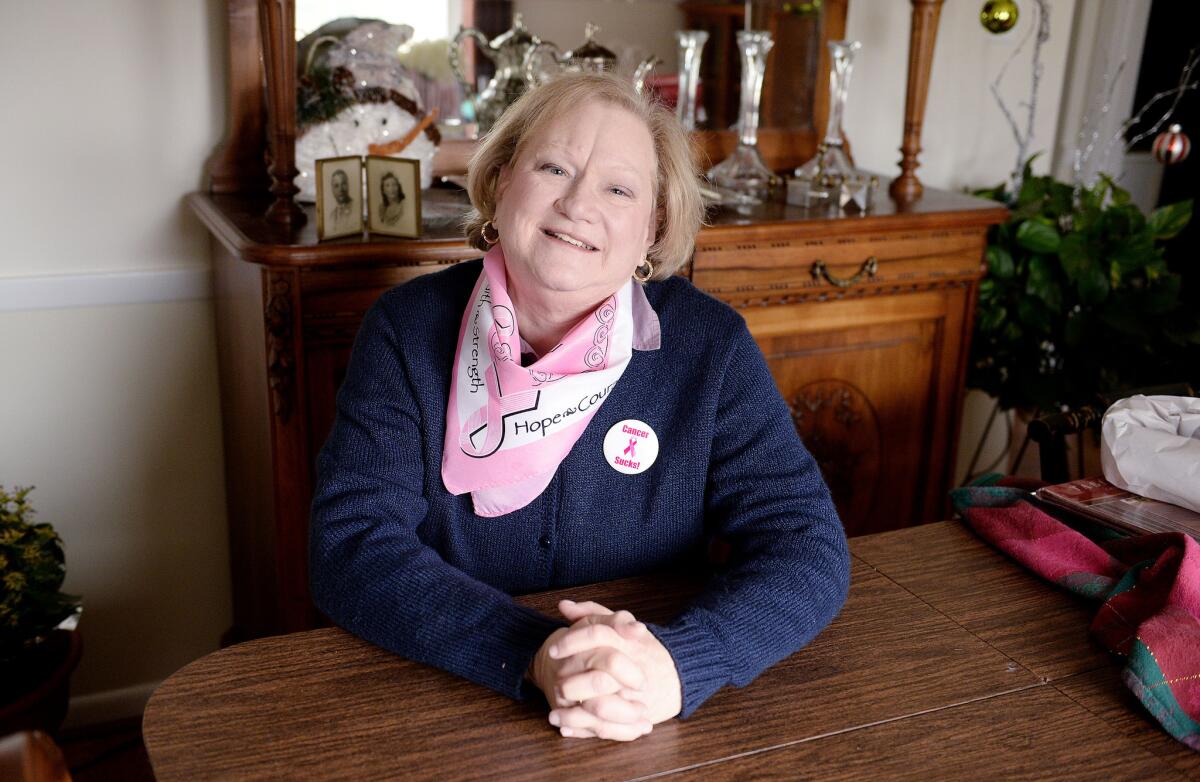Obamacare’s guaranteed health coverage changes lives in first year

- Share via
Reporting from Alexandria, Va. — Like many working Americans, Lisa Gray thought she had good health insurance.
That was until she was diagnosed with leukemia in mid-2013, and the self-employed businesswoman made a startling discovery: Her health plan didn’t cover the chemotherapy she needed. “I thought I was going to die,” Gray, 62, said recently, recalling her desperate scramble to get lifesaving drugs.
Through a mix of temporary measures, doctors and patient advocates managed to keep Gray stable for a few months.
But it was a new health plan through the Affordable Care Act that Gray credits with saving her life. The plan, which started Jan. 1, 2014, gave her access to the recommended chemotherapy. Her cancer went into remission in the fall.
It is now one year since the federal law began guaranteeing coverage to most Americans for the first time, even if they are sick.
Some consumers pay more for insurance. Some pay less. Doctors, hospitals and businesses are laboring to keep up with new requirements. And across the country, “Obamacare” remains a polarizing political issue.
For many Americans like Gray — who were stuck in plans that didn’t cover vital services or who couldn’t get insurance because of a preexisting medical condition — the law has had a personal, even life-changing impact.
“A couple years earlier, I think I would have been done,” Gray said.
Even the law’s supporters concede more must be done to control healthcare costs and ensure access to care.
But the insurance guarantee — which includes billions of dollars in aid to low- and middle-income Americans — has extended coverage to about 10 million people who previously had no insurance, surveys indicate. That cut the nation’s uninsured rate more than 20% last year, the largest drop in half a century.
The law also changed coverage for millions more people who were in plans like Gray’s that capped or excluded benefits, a once-common feature of health insurance that is now banned.
Working out of a trim, white Colonial in suburban Washington, D.C., Gray thought little of these potential changes when President Obama signed the health law in the spring of 2010. She didn’t involve herself in politics. She’d had health insurance for decades.
With a monthly $1,095 premium, the Kaiser Permanente plan that she had gotten through her husband’s employer wasn’t cheap.
But it was her only option. As a breast cancer survivor, Gray probably wouldn’t have been able to find a new plan; insurers in 2013 could still turn away consumers with preexisting medical conditions.
Gray was focused on her business as a consultant who helped companies put together bids for government contracts.
In her free time, she volunteered with Susan G. Komen, the nation’s largest breast cancer foundation. “I was in give-back mode,” said Gray, who sports a pink ribbon on her car and displays a pink Halloween pumpkin on her lawn every year.
Then, on the morning of May 20, 2013, Gray skidded off the road driving to her vacation condominium on Maryland’s Eastern Shore. Aside from a few bruises, she was unhurt.
But she had a bigger surprise at the emergency room. A routine blood test showed an unusually high white blood cell count.
Gray had chronic myeloid leukemia, a relatively uncommon form of cancer that starts in the bone marrow and leads to the production of abnormal blood cells.
The disease is now considered highly treatable. Gray’s oncologist at Kaiser prescribed the standard oral chemotherapy, a medication known as Gleevec.
Much relieved, Gray called her pharmacy to pick up the prescription.
There was a pause on the line. The pharmacist asked Gray if she knew the drug would cost $6,809 a month.
“I freaked out,” she recalled. “Why would they even make this drug if people can’t afford it?”
Neither Gray nor her doctor realized her Kaiser plan only covered $1,500 worth of prescription drugs a year, a provision spelled out in small type in Appendix B of her 80-page plan brochure.
Caps on coverage were once routine; most commercial health plans once put some kind of annual or lifetime limit on how much care they covered.
“Patients often didn’t know they had inadequate coverage until they were diagnosed with a catastrophic illness,” said Dr. S. Yousuf Zafar, an oncologist at Duke Cancer Institute who studies how costs affect cancer care.
Gray desperately looked for help.
She earned too much to qualify for most charity programs that drug makers offer. Kaiser wouldn’t lift her drug cap. And with a cancer diagnosis, she wouldn’t be able to get a new insurance plan.
At one point, she emailed her sister, a former radiation oncologist, to ask about the life expectancy for her cancer without treatment.
“It’s not an option,” her sister, Cecily Bullock, wrote back.
Gray’s family explored going to Canada, where pharmaceuticals are often less expensive. They finally found a clinical trial closer to home at the University of Maryland, Baltimore, where researchers were testing an alternative to Gleevec called ponatinib.
Gray’s cancer quickly responded. The relief was only temporary, however. In late July, she was hospitalized with pancreatitis, a potentially dangerous inflammation of the pancreas.
The next month, Gray had to stop the ponatinib. Without access to either drug, she was again scrambling.
Bristol-Myers Squibb, which provides cancer patients with a temporary insurance card for a 30-day supply of yet another cancer drug, seemed to offer hope. But the card wasn’t accepted at the Kaiser pharmacy where Gray had to get her prescriptions.
American Cancer Society advocate Brandon Costantino, who works with patients at the University of Maryland, Baltimore, persuaded a company sales representative to give Gray a month’s supply anyway.
Then Gray had to contend with yet another obstacle: Patients could typically only get one month of the drug from the manufacturer. She needed a second to keep up treatment through December.
“It was like brick wall after brick wall that we had to chisel through,” said Costantino, who went back to Bristol-Myers Squibb to get the additional chemotherapy. “My mantra for Lisa was: ‘We just need to get you to 2014,’” he said.
Even the promise of a new insurance plan under the Affordable Care Act seemed elusive at first. Gray, like others, battled through the problems that hobbled HealthCare.gov after it opened. “I must have called 85 times or more,” she said.
Finally, on Dec. 2, 2013, she selected a new Kaiser Permanente health plan for $780 a month. That was $315 less than her current plan. Most important, the plan covered Gleevec for a $30-a-month co-pay.
Gray broke down in the pharmacy when she picked up her first prescription last January — she’s “kind of a crier,” she admits.
Nine months later, a bone marrow biopsy showed no further sign of leukemia.
Today, Gray is healthy, aside from the occasional sinus infection.
Sitting on her living room couch with her dog, Gray says she is somewhat bewildered by the controversy that continues to shadow the health law.
“I don’t understand why people get so mad.... It’s just health insurance,” she said, describing conversations with friends and neighbors who say the law should be repealed. “I tell them, ‘You have to understand, there are people who need this. I mean really, really need this.’”
More to Read
Sign up for Essential California
The most important California stories and recommendations in your inbox every morning.
You may occasionally receive promotional content from the Los Angeles Times.











